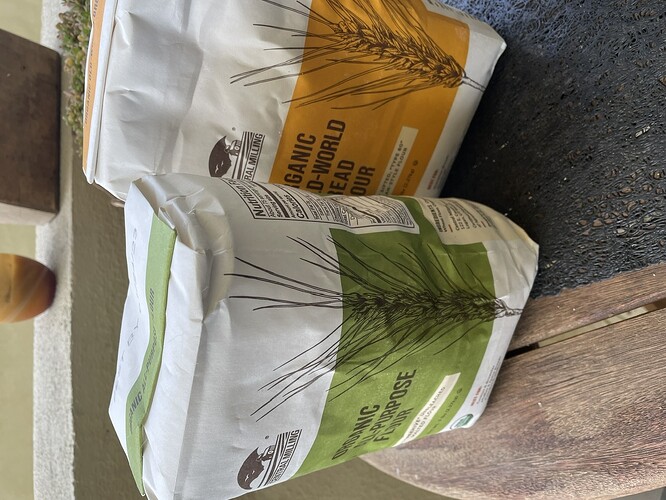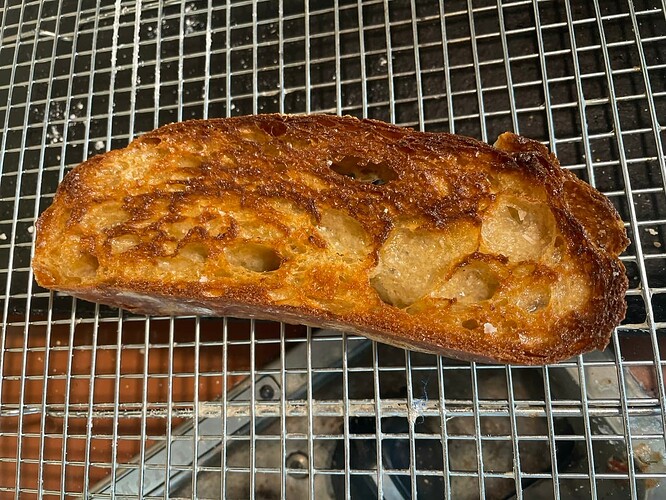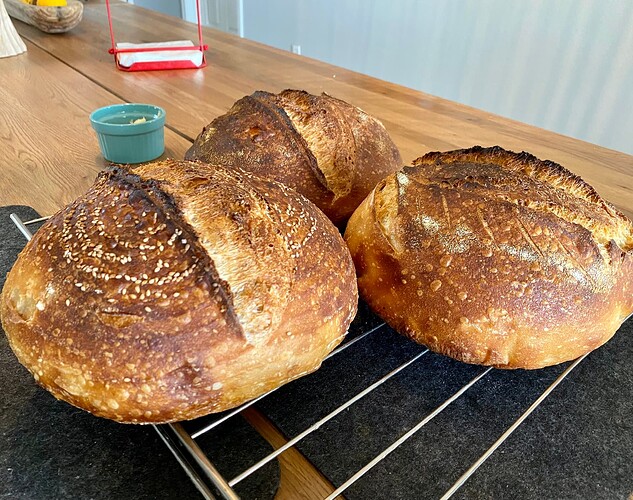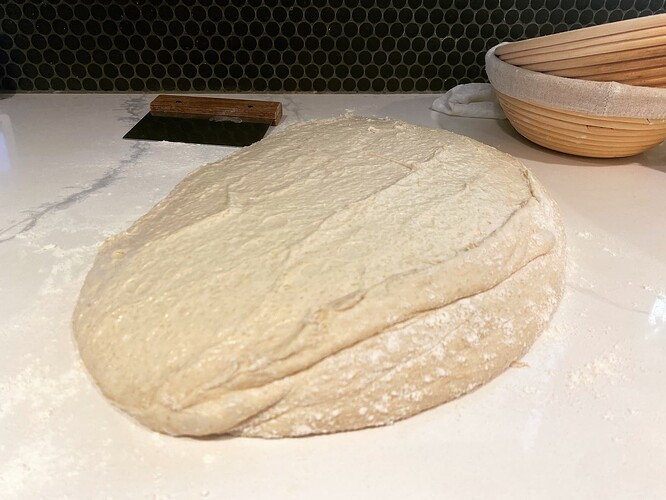Looks great, but maybe a higher temp for baking? Nice wet dough to give you the open structure, but looks like you want a little more Maillard reaction for the crust.
Needs a little pastrami and mustard to complete the picture…
The joys of having an ancient oven! You are right and my digital oven thermometer went on the fritz so that needs to be replaced asap
I’ve been making sourdough every 2 weeks or so for almost two years and always seem to wind up with a crumb that is more dense than what I’ve seen as the model to achieve. My starter is homemade and this last time tripled after being refreshed After using several different methods, with varying fold techniques, autolyse times, fridge times, etc… I’m wondering if if might be the flour. I’ve been using King Arthur unbleached bread flour. Hydration has varied from 65-75%.
Truthfully, I’m not sure I want a crumb with large holes, which is the supposed ideal, but I do think a less dense result than I’ve been getting would be more ‘digestible’.
Any thoughts appreciated.
I am not a sourdough expert so hopefully someone like @Nemroz can weigh in.
That said here are some thoughts:
How long is your final proof after forming the loaves? If your starter triples do your loaves at least double? Are you rising them in a banneton or freeform?
As you suspect King Arthur bread flour is high protein and therefore high gluten so perhaps try AP flour rather than bread flour;
As your hydration levels are great maybe put a bit of yeast in and/or mix in some diastatic malt powder and perhaps a bit of crushed vitamin C to punch up the rise.
Your loaf looks delicious. Best of luck perfecting it!
Final proof was 3 hours at room temp after 12 hours in the fridge - all in a banneton. The dough rose maybe 75% and stayed there until final shaping.
I get the sense that my gluten development is sub-par despite the rise. A friend adds some vital wheat gluten but I haven’t tried that yet.
I’m not the baker that @ebethsdad or @Nemroz is, but I agree w/ trying AP flour. I assume that, since you’re doing long proving times, you don’t need the higher gluten stuff (and King Arthur’s AP I think is already a little higher in gluten in that, say, Gold’s AP).
Have you tried the first proving at room temp? Or do you stick in the fridge after the folding?
I baked a loaf this weekend. I used the Ken Forkish recipe (again), which has a combo of (mainly) AP flour, plus a small amount of wheat and rye. Hydration is 78% (from what I read; I didn’t do the calculation).
I once read on a thread on The Fresh Loaf that someone just does the folding, proves once, and then bakes b/c they didn’t think their starter was strong enough for 2 rises. I don’t think my starter is strong enough for that, either. But I never found directions for what amounts to a single proving until recently…
She does the first proving at room temp until the dough increases by 50-75% (using a straight sided container; IMHO, it’s really hard to say how much a dough has actually risen in a banneton b/c it’s so much narrower at the bottom). Then she shapes and then sticks it in the fridge for up to 48 hrs. She says that this schedule gets her a pretty consistent result.
I did mine for ~18 hrs and got this:
Way more air bubbles on the surface than I’ve gotten b/f. And decent oven spring. My scoring could use a lot of improvement, though.
After 4 hrs cooling (I used the Julia Child method @ebethsdad mentioned above). The crust did go soft, but I think that’s b/c I could’ve baked it longer (crust is rather blonde). Crumb was a bit moist, but not gummy, and pleasantly sponge-y. And, it dried out quite nicely after I sliced it and let it sit out for a few more hrs.
Taste was a bit too sour for my liking, but partner really liked it.
Not sure if this result was just a lucky fluke, but I do plan to try it again.
I’m really loving T 80 ‘old world European bread flour’ from Central milling i just picked up at Surfas. Need to work on slashing with more confidence but it is easy to work with and tastes good.
For me I think it’s this that’s the issue. I think ideal performance is to bake straight from the cold retard / fridge phase. Taking it out and proofing later after cold is likely causing yeast to be tired, sleepy, so i’m guessing this is underproofed. My best results have been
refresh starter night before mixing, morning of mixing you feed starter to get to the starter weight you’re after. Let that peak. Mix in. Rest. 4 sets of stretch and folds every half hour. 3 hour bulk ferment / proofing (needs to bulk a lot but not crazy). Separate, preshape, final shape, fridge.
I agree you dont need huge holes, just uniform medium holes. This certainly looks dense. Flour is another thing that’s a pain to nail down but I don’t see an issue with using bread flour, i’d just mix in some whole wheat too for health
Whole wheat tends to have a negative effect on the gluten development - so if you want larger bubbles I would avoid whole wheat
you’re right. but i think that’s for a lot of whole wheat… i haven’t had these issues… and i’m talkin about 10-15% of the flour blend being WW. with a consistent process and healthy starter proofing shouldnt be affected
from this weekend
Browning and crumb look dreamy.
If you and/or @Nemroz have a moment, could you post a video of your scoring method(s)?
I’m assuming that my stinky scoring is also maybe a sign of overproofing (based on what I’m reading here: Breadmaking 101: How to Troubleshoot Bad Bread), but I also think my scoring technique stinks. Yes, I’ve watched videos. But they tend to score SO quickly, that I’m like, “What…?”
I’ve tried a lame, my usual serrated bread knife, even kitchen shears (based on seeing it in another video), and it’s just… not pretty (literally).
My wife has good success using a razor blade.
High hydration loaves don’t score well in my experience. Noting that I have had better luck wetting the loaf before I score it. Go figure…
Interesting! I spritz the bread before it goes in the oven but I’ve never before scoring. Just ordered a ufo style bread lame, we’ll see how works out but I k know people that swear by them
Dough has to be cold and a razor needs to be sharp. Razors came in a basic banneton set i got years ago. 45 degree angle, almost end to end, fairly deep. hold dough with thumb and index on one end and score. I’ll try to record.
Thought I would resurrect this old thread. Made Zingerman’s award winning Jewish rye from their cookbook, https://www.amazon.com/Zingermans-Bakehouse-Amy-Emberling/dp/1452156581/ref=sr_1_1?crid=GIDTJLJPK164&keywords=zingerman’s&qid=1678933848&sprefix=zingerman’s%2Caps%2C892&sr=8-1, today. Really, really good!
Interesting recipe uses a “rye sour”, which seems to be a cross between a rye levain and a poolish. Crumb is finer than my usual open textured baguettes, but I think it will work well for sandwiches. It’s surprisingly light, and very tasty.
glorious! someone shared Dutchess Rye PORRIDGE bread with me yesterday and it was pretty dang amazing!
With the exception of fiber, nutritionally whole-wheat flour is almost identical to white flour, so if you eat plenty of high-fiber foods like vegetables and fruits there’s no nutritional advantage.
Maybe this has been discussed already but… what hydration do you all keep your starter at? Mine is 100%, but I’m wondering if should keep it at, say, 80% so that I can skip the step of making another starter for the bread dough itself…











